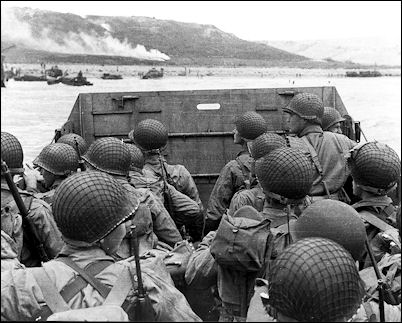
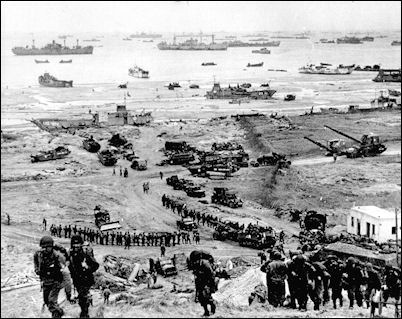
The Axis Powers' begin to Lose
D-Day happened on June 6, 1944. It was planned for months. It came about via Soviet pressure. The Western Allies on D-Day invaded Normandy on Omaha Beach. D-Day was successful, but a lot of Allied soldiers lost their lives in the invasion. D-Day’s codenamed was Operation Neptune. The Allied invasion of Normandy was the largest seaborne invasion in history. The Allies prepared for months for this invasion and tried to mislead the Germans as to the date and location of the main Allied landings (which was codenamed Operation Bodyguard). Hitler made German Field Marshal Erwin Rommel to be in command of the German forces. Rommel created fortifications along the Atlantic Wall since they knew that the Allied invasion was coming. Group Captain James Stagg (or the Royal Air Force of the RAF) met with General Eisenhower to discuss about the beat time to invade from a weather standpoint. Before the amphibious landings, there were extensive aerial and naval bombardments including an airborne assault. The landing of about 24,000 British, U.S., and Canadian airborne troops came about shortly after midnight. In 01:00, the first Navy hands are ordered to man battle stations. The landing craft begin to be lowered into the water and paratroopers cut phone lines and knock down telephone poles. In 0:300, Gliders begin to reinforce the paratroops. 9 minutes later, German radar detects Allied invasion fleet so Admiral Krancke of Germany ordered shore batteries to prepare for invasion. At sunrise in 05:20, bombers drop bombs on German targets. Allied infantry and armored divisions landed on the coast of France at 06:30.
The Allies divided the Normandy coast into five sectors of: Utah, Omaha, Gold, Juno, and Sword Beach. When the soldiers landed on the beach, they faced heavy gunfire from the Nazis. Omaha had the most causality. The each was very dangerous, but courageous men fought the Nazis. Also, the Allies work with the French Resistance movement (like the État-major des Forces Françaises de l'Intérieur or the London based Forces of the Interior) to fight the Nazis in various locations in France during D-Day too. The Allies had victory in Normandy, because German preparations weren’t finished, Germans were confused on what to defend, the Allied had better air fighting resources, and transport infrastructure in France was disrupted (by Allied bombers and the French Resistance. This made it hard for the Nazis to bring up reinforcements and supplies). In total, D-Day consisted over 160,000 Allied troops and about 30,000 vehicles landing along a 50 mile stretch of fortified French coastline. The Allies were victorious. The Germans had 1,000 casualties while Allied casualties were at least 10,000 human beings with 4,414 confirmed dead. Museums, war cemeteries, and memorials are in the area today.
In September 1944, the Soviet Red Army troops came into Yugoslavia and forced the rapid withdrawal of the German Army Groups E and F in Greece, Albania, and Yugoslavia to rescue them from being cut off. Marshal Josip Broz Tito led the Communist Partisans in Yugoslavia. What he died what the he led an increasingly successful guerilla campaign against the occupation since 1941. He controlled much of Yugoslavia. His forces delayed efforts against German forces south too. The Red Army with limited Bulgarian support assisted the Partisans in a joint liberating of the capital city of Belgrade in October 20. Days later, the Soviets launched a massive assault against German-occupied Hungary that lasted until the fall of Budapest in February of 1945. There were massive Soviet victories in the Balkans. Yet, there was massive Finnish resistance to the Soviet offensive in the Karelian Isthmus. There would be no Soviet occupation of Finland, so both sides signed a Soviet-Finnish armistice on relatively mild conditions. Finland would join the Allied side.
In the Pacific, on July 1944, Commonwealth forces in Southeast Asia had repelled the Japanese sieges in Assam. This pushed the Japanese back to the Chindwin River. By July 27, 1944, the Allies liberated Guam. The Chinese captured Myitkyina. In China, the Japanese were having greater successes. The Japanese finally captured Changsha in mid-June and the city of Hengyang by early August. Soon after, they further invaded the province of Guangxi, winning major engagements against Chinese forces at Guilin and Liuzhou by the end of November and successfully linking up their forces in China and Indochina by the middle of December. In the Pacific, the American forces continued to press back the Japanese perimeter. In mid-June 1944 they began their offensive against the Mariana and Palau islands, and decisively defeated Japanese forces in the Battle of the Philippine Sea. These defeats led to the resignation of the Japanese Prime Minister, Hideki Tojo, and provided the United States with air bases to launch intensive heavy bomber attacks on the Japanese home islands. In late October, American forces invaded the Filipino island of Leyte; soon after, Allied naval forces scored another large victory during the Battle of Leyte Gulf, one of the largest naval battles in history.

Historic Conferences and Agreements
US-USSR Mutual Aid Agreement (1942): This agreement was formed in order to allow the United States to aid the USSR in military and other supplies in order for the Nazis and the rest of the Axis Powers to be defeated.
Casablanca Conference (1943): This Conference dealt with the Allied Powers deciding on what to do in the future in defeating the Axis enemies. In other words, it was meeting to outline the next phase of World War II. It was held in the Anfa Hotel in Casablanca, French Morocco. It lasted from January 14 to 24, 1943. Franklin Roosevelt and Winston Churchill attended the meeting. Other people who attended were Generals Charles de Gaulle and Henri Giraud (who represented the Free French forces). Primer Joseph Stalin didn’t attend since he had to support the Soviet troops fighting the Nazis in Stalingrad. All parties agreed with to support Chiang Kai-Shek in his usage of the Chinese armies to defeat the Japanese occupation of China. They promise aid to the Soviets in their fighting against Germany. They united with the French to defeat the Axis. They were unified in desiring the defeat of Germany and Japan. This conference promoted the ideal that all Axis Powers must be defeated in terms of "unconditional surrender" which was controversial as time went on in the war.
Moscow Conference (1943): This Conference took place in the Kremlin and the Spiridonovka Palace from October 18 to November 1943. It was made up of a series of meetings between the foreign ministers of the United States (like Cordell Hull), the United Kingdom (like Anthony Eden), China (like Foo Ping-sheung), and the Soviet Union (like Vyacheslav Molotov). The meeting involved discussions about the necessity to end the war with the Axis and to go forward as the war is over. It favored restoring democracy in Italy. They wanted Austria to be liberated and they condemned the war crimes done by the Nazis and other Axis forces during the war. The statement on Atrocities by the Axis Powers was signed by President Roosevelt, Prime Minister Winston Churchill, and Premier Stalin.
Cairo Conference (1943): The meeting happened from November 22-26, 1945. This conference dealt with the Allies and Japan during World War II. It also related to the decisions about postwar Asia. The Conference was held by Chiang Kai-shek, Franklin Delano Roosevelt and Winston Churchill. Stalin didn't attend, because Chiang was attending, which could cause friction between the Soviet Union and Japan. Back in 1943, there was the Soviet-Japanese Neutrality Pact of 1941. It was a five year agreement of neutrality among both nations. The Soviets were not at war with japan during 1943. Yet, the U.S., China, and the U.K. were at war with Japan. The conference took place at a residence of the American Ambassador to Egypt (Alexander Kirk) near the Pyramids. They decided that Japan must have “unconditional surrender” via a military defeat. They agreed to want all lands stolen from the Chinese (which would include Manchuria, Formosa, and the Pescadores) to be restored to the Republic of China. They wanted Japan expelled from all territories that were taken by them.

Teheran Conference (1943): This conference was codenamed “Eureka.” It was held from November 28 to December 1, 1943. It was held in the Soviet Union’s embassy in Tehran, Iran. This was a strategy meeting held among Franklin D. Roosevelt, Joseph Stalin, and Winston Churchill. This was the first major conference where all three nations would talk about future of WWII. All three leaders had differing objectives. The Soviets wanted more support and the Allies to target France on the Eastern front. The British wanted a gradual push in Western Europe with the maintenance of the British Empire colonies. America wanted continued support in the Pacific and for the Soviets to invade Japan. Stalin coordinated the conference, because the Soviets won the decisive Battle of Kursk. All three men agreed with support the Yugoslav Partisans. They desired Turkey to fight for the Allied side by the end of the year. The Allies would invade France to free them from Vichy Nazi occupation by May 1944. Also, all three countries would keep close touch with each other regarding future operations in Europe.
The Second Quebec Conference (1944): This meeting was a high level military conference from September 12, 1944 to September 16, 1944. The first one was in August of 1943. The chief represents were Winston Churchill and Franklin D. Roosevelt including the Combined Chiefs of Staff. Canada’s Prime Minister William Lyon Mackenzie King was the host but didn’t attend the key meetings. All parties agreed to form Allied occupation zones in defeated Germany. They wanted the Morgenthau Plan to demilitarize Germany and the continued U.S. Lend-Lease aid to British. They talked about the role of the Royal Navy in the war against Japan.
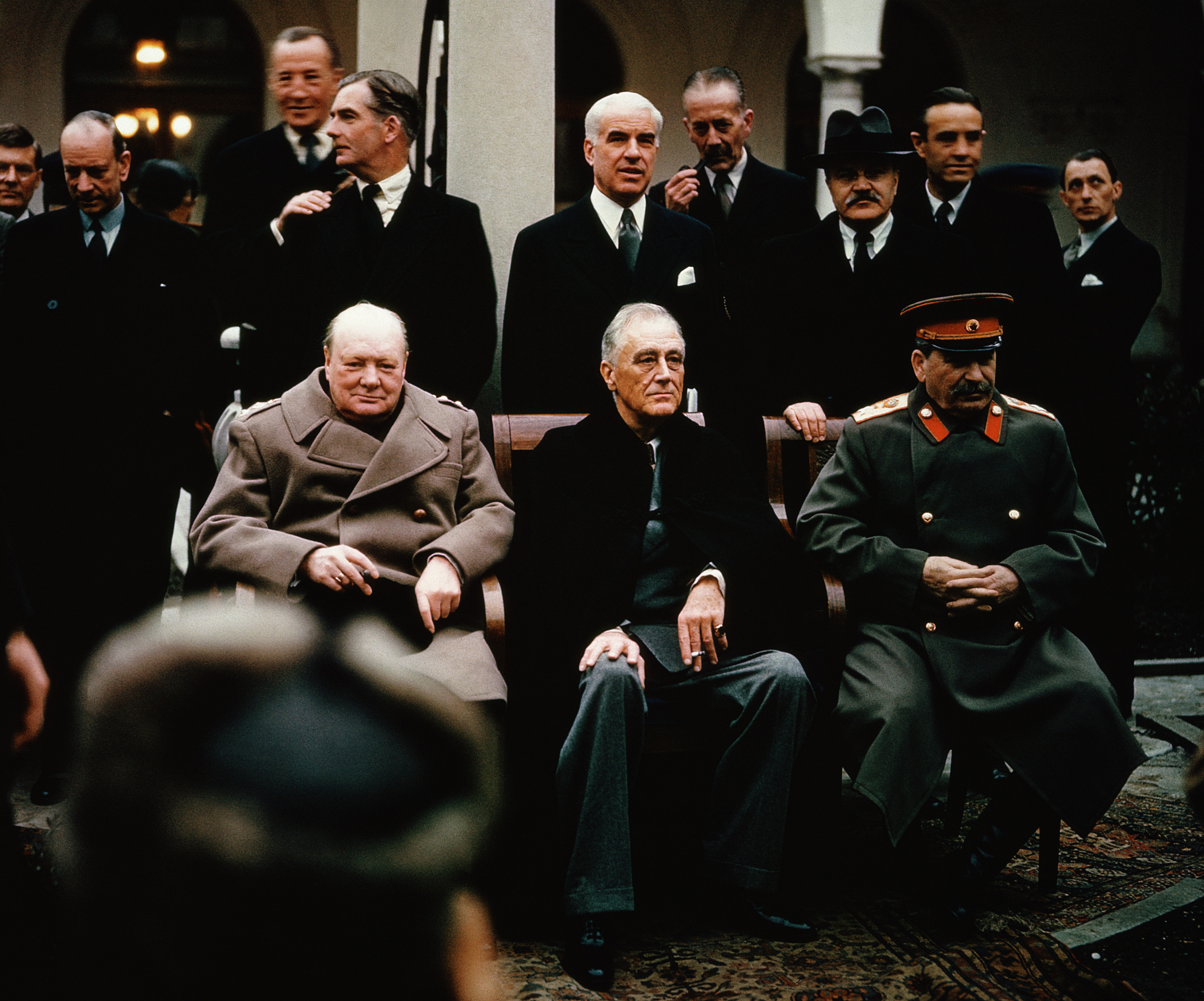
Yalta Conference (1945): This conference was one of the most important, historic conferences of World War II. This was the last major international conference of Franklin Delano Roosevelt. It lasted from February 4 to 11, 1945. It was held in the Livadia Palace near Yalta in the Crimea. It was codenamed “the Argonaut Conference.” The meeting included Roosevelt, Churchill, and Stalin. Also, there were other people there too. There was the Soviet Foreign Minister Vyacheslav Motolov. Other British people included Field Marshal Sir Alan Brooke, Admiral of the Fleet Sir Andrew Cunningham, RN, Marshal of the RAF Sir Charles Portal. There were the Americans there like General George C. Marshall, Chief of Staff of the United States army, and Fleet Admiral William D. Leahy, USN. The Yalta Conference was about the discussions of how to deal with post-war Europe, establishing in dealing with Germany and Poland. America, the UK, and the Soviet Union were called the Big Three too. The meeting discuss on the re-establishment of nations of war torn Europe. Stalin by this time has conquered most of the Nazis forces on the Eastern front. Soviet forces were in Poland and in parts of Romania. Red Army Marshal Georgy Zhukov’s forces were only 40 miles from Berlin. Roosevelt wanted Russia to participate in the United Nations. Churchill was always suspicious of Stalin. He just didn’t trust Stalin, because of ideological reasons. Roosevelt also wanted Soviet support in the U.S. Pacific War. Churchill (including Roosevelt) wanted Stalin to get free elections and democratic governments in Eastern and Central Europe, especially in Poland. Stalin wanted a Soviet sphere of political influence in Eastern and Central Europe as he didn’t want the Nazis to reestablish themselves ever again. Churchill supported the Polish government's in exile demands while Stalin rejected them and wanted an independent Poland on his terms. Stalin promised to Roosevelt that the Soviet Union will enter the war against Japan. The Soviets agreed to join the United Nations (given that permanent nations in the UN had veto power in making decisions). Back then, the Red Army occupied Poland and it held much of Eastern Europe. The Soviets had three times greater military power than the Allied forces in the West. All three nations agreed to form post war occupation zones for Germany (in 3 zones, one of each for the three principal Allies). They gave France a zone of occupation and carved out of U.S. and UK zones. They agreed that the Nazis must have unconditional surrender. Berlin was to be split in four occupied zones. Germany must have demilitarization and denazification. Germany must pay reparations in the form of forced labor. All agreed with Nazi war criminals being hunted down and brought to justice. The Polish government, which was communist, was to be reorganized into a broader democratic basis. The Polish eastern border would follow the Curzon Line, and Poland would receive territorial compensation in the West from Germany. Roosevelt, Churchill, and Morgenthau had different ideas on the division of Germany after WWII, but the eventual partition of Germany would include 4 zones (British, French, American, and the Soviet). Other territories of Germany were annexed by other nations.
Stalin promised free elections in Poland. Stalin agreed to fight the Empire of Japan in the future. Roosevelt at first was trusting of Stalin to follow the agreement. Stalin was fearful of Western suspicions. By March 21, Roosevelt's Ambassador to the USSR Averell Harriman cabled Roosevelt that "we must come clearly to realize that the Soviet program is the establishment of totalitarianism, ending personal liberty and democracy as we know it." Two days later, Roosevelt began to admit that his view of Stalin had been excessively optimistic and that "Averell is right." Yet, FDR cabled to the Soviet leader on April 5: “It would be one of the great tragedies of history if at the very moment of the victory, now within our grasp, such distrust, such lack of faith should prejudice the entire undertaking after the colossal losses of life, material and treasure involved. Frankly I cannot avoid a feeling of bitter resentment toward your informers, whoever they are, of such vile misrepresentations of my actions or those of my trusted subordinates.”
A recent biographer of Lippmann summed up the columnist’s overall appreciation of the FDR policy in early 1945: “At Yalta FDR thought he had laid the groundwork for a durable peace. Stalin had agreed to enter the war against Japan, to allow free elections in Eastern Europe, and to accept the American formula for a United Nations resting on a great-power veto and spheres of influence. The United States would stand as mediator between the rival imperialisms of Britain and Russia. With its overwhelming economic strength, its predominance in Latin America, its undisputed naval power in the Pacific, its incomparable industrial and military machine, its control over the world’s raw materials, the United States would have nothing to fear from a devastated and war-impoverished Russia. This great scheme would all be codified in May, Roosevelt thought, in San Francisco with the creation of the United Nations.” [Steel, p. 417] On the day of his death, FDR did something progressive again. He sent Stalin a conciliatory cable from Warm Springs in which he dismissed the Italian “secret surrender” controversy as a “minor misunderstanding” between Moscow and Washington. Harriman refused to send that cable to Stalin. So, Harriman, Stimson, and others wanted massive tensions between American and the Soviets, which ultimately caused the Cold War.
FDR knew of the errors of Stalin in his violations of democratic rights of many peoples, but he wanted cooperation instead of conflict with the Soviets. In a telegram to Churchill on April 11, he wrote: "I would minimize the general Soviet problem as much as possible because these problems, in one form or another, seem to arise every day and most of them straighten out as is the case of the Bern meeting"—a suspicion by Moscow that the Allies were trying to cut a separate deal with German forces based in Italy. "We must be firm, however, and our course thus far is correct." So, Franklin Delano Roosevelt wanted peace not excessive tensions with the Soviet Union. The American view was reflected in the final Yalta agreement: “The Provisional Government which is now functioning in Poland should…be reorganized on a broader democratic basis with the inclusion of democratic leaders from Poland itself and from Poles abroad. This new Government should then be called the Polish Provisional Government of National Unity.”
The pro-Soviet Lublin Polish government delayed in the free elections causing tensions. Later, many Eastern European nations were occupied by the Soviets and turned into Soviet-controlled satellite states. Eventually the United States and the United Kingdom made concessions in recognizing the then Communist-dominated regions. All Allied Powers agreed with the Statement on liberated Europe. Reactionaries today denounce Yalta to this very day as a give away to Stalin. Yet, the Yalta Agreement was a realistic acknowledgement of how Europe was. Yalta didn’t give Stalin all of Eastern Europe, because Eastern Europe was already heavily controlled or influenced by the Soviet Union in the first place. It would be foolish for the US and the UK to fight the Soviets during Yalta since the Soviets had sacrificed their blood to end Nazi oppression (and the Red Army has more military power than the rest of the Allied forces in Europe during that time of early 1945. THE US AND THE UK didn’t have the military forces during that time to defeat the Soviets completely anyway). Yalta would go down as an important meeting and a prelude to Potsdam.

Postdam Conference (1945): This Conference lasted from July 17 to August 2, 1945. The meeting included President Harry Truman, Prime Ministers Winston Churchill and Clement Attlee, and Communist Party General Secretary Joseph Stalin. The world has changed since Yalta. The conference was held at Cecillenhof, which was the home of Crown Prince Wilhelm Hohenzollern (in Potsdam, occupied Germany). The conference session included also Ernest Bevin, Molotov, William D. Leahy, Joseph E. Davies, and James F. Byrnes. Times have changed. Churchill lost the election to Attlee, so Attlee was there too. The Potsdam meeting about the Allied powers talking about post-war order, peace treaty issues, Germany, Poland, and Indochina (or Vietnam). Churchill by this time continued his distrust of Stalin. The Soviet Union was occupying Eastern and Central Europe. Stalin formed a communist government in Poland. President Harry Truman was the new President after the passing of President Roosevelt on April 12, 1945. Truman was more on Churchill’s side on his views of the Soviets. Truman didn’t trust the Soviets that much and his views were influenced by Harriman and Stimson including Byrnes. Truman was much more suspicious about communist actions than Roosevelt was.

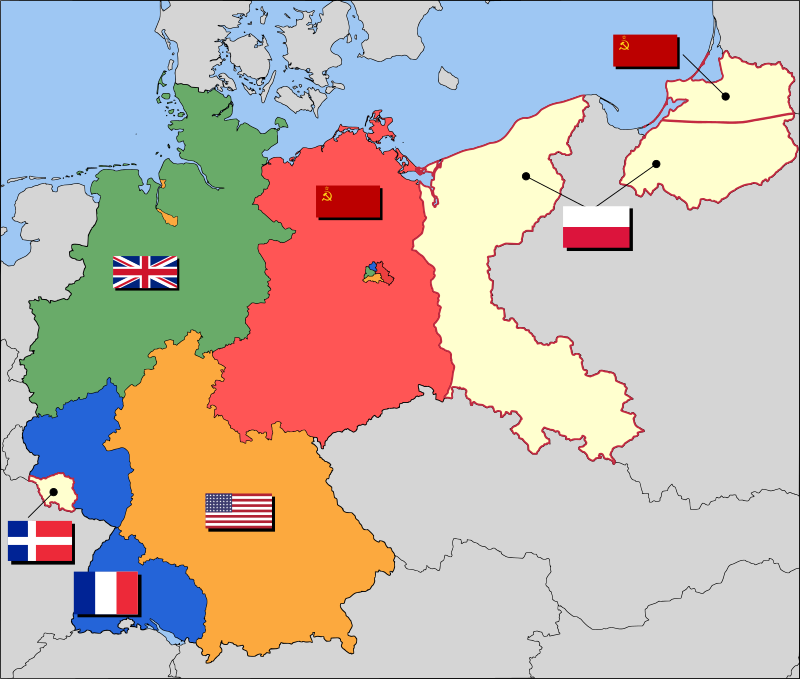
The Allies agreed to temporarily partition Vietnam at the 17th parallel (just North of Da Nang). British forces would take the southern half of Vietnam while the northern half would be ruled by the Chinese. ON Germany, all sides agreed firmly. The Allies divided Germany via demilitarization, denazification, democratically, decentralization, and decartelization. Germany and Austria would be divided into four occupation zones. Berlin and Vienna would be divided into four zones too. They agreed to prosecute Nazi war criminals. The German annexations of Europe would continue. Germany’s industry and agricultural would never be used for explicit military purposes to. The agreement would make Poland a provisional Government of National Unity (recognized by all three powers). The Polish government in exile wasn’t recognized. Poles who were serving in the British Army should be free to return to Poland, with no security upon their return to the communist country guaranteed. During the time, Truman had allowed the testing of the atomic bomb in New Mexico. Truman had mentioned an unspecified "powerful new weapon" to Stalin during the conference. Towards the end of the conference, Japan was given an ultimatum to surrender (in the name of the United States, Great Britain and China) or meet "prompt and utter destruction", which did not mention the new bomb. Truman was happy at the conference. On July 26, Churchill, Truman, and Chiang Kai-Shek (or the Chairman of the Nationalist Government of China) issued the Potsdam Declaration which outlined the terms of surrender for Japan during World War II in Asia. The many nations of the Baltic and Eastern Europe would be converted into Soviet Satellite states. In essence, the Potsdam conference set the stage for the Cold War.

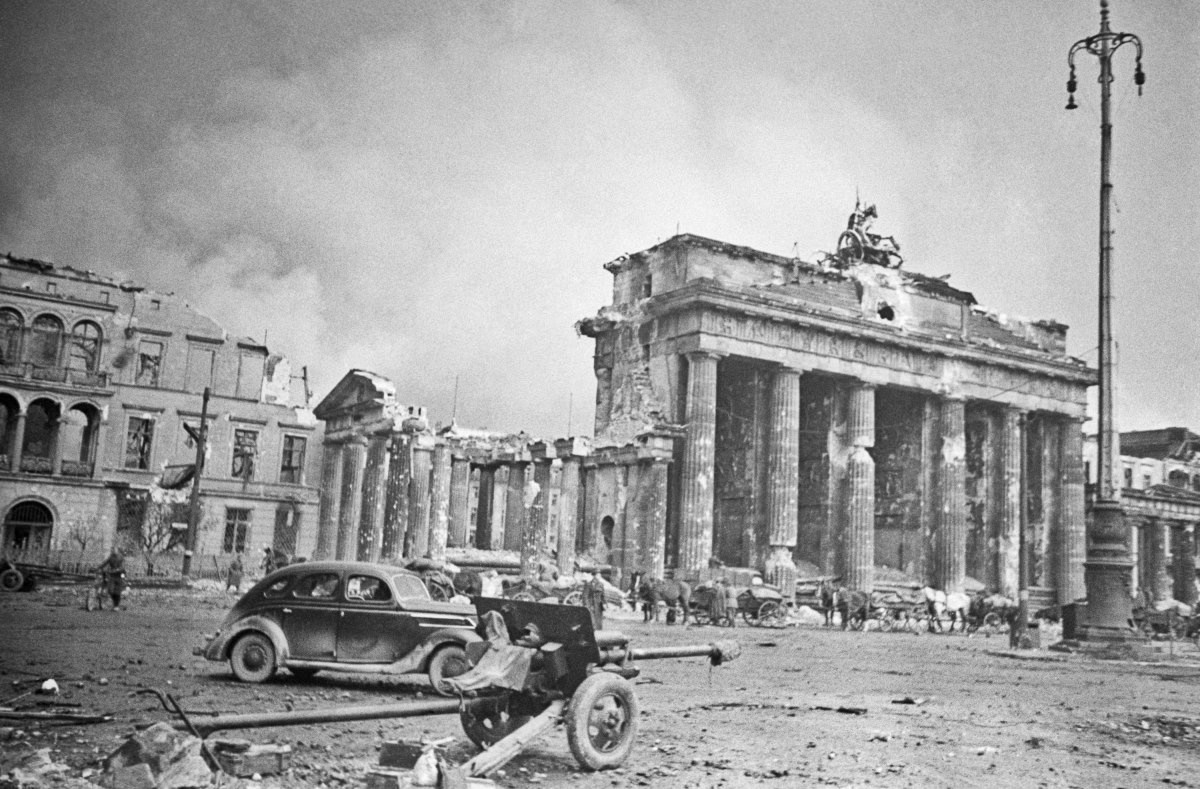
The Axis Collapses and the Allied Victory
By late 1944, the Axis Powers were about to be defeated. Germany attempted is last desperate measure for the success on the Western Front on December 16, 1944 by using most of its remaining reserves to launch massive counter-offensives in the Ardennes. The Nazis wanted to split the Western Allies, and then encircle large portions of Western Allied troops. In that way, the Nazis would capture their primary supply port at Antwerp and prompt a political settlement. Yet, the Allies wanted complete surrender. The Battle of the Bulge lasted from December 16, 1944 to January 25, 1945. It involved one major, desperate offensive made by the Nazis in order for them to try to force a treaty with the Allies while still fighting the Soviets. The conflict took place in the densely forested Ardennes region of Wallaonia (in Belgium, France, and Luxembourg) on the Western Front. The Americans were happy to liberate Paris and many parts of France. The Canadians and the English took the port city of Antwerp while the Americans (with Generals like Patton and Eisenhower) were targeting the Rhone River with German territory just beyond. Hitler wanted to go to the port city of Antwerp and disrupt by the Allied front and disrupt their much needed supply lines along with way. On December 16th, the Nazis executed their massive offensive first. German 5th and 15th Panzer armies and the 6th and 7th Army (in about 250,000 Nazi troops and fiver panzer or tank divisions) attacked the US VII forces in a line between Aachen and Bastogne. This German surprise attack surprised the Allies. Many contingents like the U.S. 2nd Division at Elsenborn and the 99th Division at Malmedy held their ground. The Nazis push into the Allied lines 50 miles causing a bulge. The battle of the Bulge was filled with snow. The Allied and the Axis Powers would fight at the small town of Bastogne. The Allied forces were dug in for weeks in strong fighting. U.S. General Omar Bradley sent General Courtney Hodges’ 1st Army and General Patton’s 4th Armored Division to the town to head off further German advance. The 101st Airborne was airdropped into Bastogne to aid in its defense. The 82nd Airborne took the task in St. Vith. The Allies lines were fractures and independent defenses soon sprung about.
There were poor weather conditions, so air support would not come immediately. On December 17th, 1944, Allied prisoners of war are executed in cold blood by elements of the 6th SS Panzer Army in the Malmedy Massacre. Over 80 U.S. prisoners of war (from the from the 285th Field Artillery Observation Battalion) were killed by the order of German Colonel Joachim Peiper in the Malmedy Massacre. The Nazis captured the town of Stavelot in the same day of the 17th too. 2 days later, 2 components making up the U.S. 106th Division at the Schnee Eiffel region are surrounded by the Nazis. About 6,000 Allied troops surrendered to the encircling Germany Army at Schnee Eiffel on December 19, 1944. Then, the U.S. forces use a massive counter attack and recaptured the town of Stavelot, Belgium in December 21, 1944. The Germans captured St. Vith on December 21, 1944. In December 23nd, 2,000 Allied air sorties launch attacks against the Germans on the ground. One day after Christmas 1944, the American 4th Armored Division (under General George Patton) makes its way to the beleaguered 101st Airborne at Bastogne and the situation in the village is stabilized. Hitler refuses to retreat at this point. On December 31, 1944, U.S. troops recaptured Rochefort, Belgium, and the U.S. Army began an offensive from Bastogne. British General Montgomery’s 29th Armored Brigade met up with the American 2nd Armored Division to hold the point of deepest German penetration in check later on. On January 1, 1945, the Germans begin to withdrawal from the Ardennes Forest in the Belgian-German border region. U.S. massacred 30 SS prisoners at Chenogne in retaliation for the Malmedy massacre. The German Luftwaffe aircraft fail to defeat the Allied forces. On January 12, U.S. and British Forces link up near La Roche-en- Ardenne. By January 28, 1945, the Nazis are finished pushed out of the Ardennes. The Battle of the Bulge was the last of the major German offensives in the war. It was a bloody war. This Battle would cause about 89,900 casualties (including 19,000 killed Americans, 47,500 wounded Americans, and 23,000 captured or killed Americans). The British had 1,408 casualties (including 200 British people killed, 969 British people wounded, and 239 British people missing). The Allies gained all the territory they had in December of 1944. The victory of the Allies in the Battle of the Bulge meant that the war was definitely soon to be over in a matter of months (with the Axis forces being defeated in Europe).
January 27, 1945 was when the Red Army of the Soviet Union liberated Auschwitz was liberated. In January of 1945, the offensive was repulsed with no strategic objectives fulfilled. In Italy, the Western Allies remained stalemated at the German defensive line. In mid-January 1945, the Soviets and the Polish people attacked in Poland. They went from the Vistula to the Oder River in Germany and overran East Prussia. February 4, 1945 was the date when U.S., British, and Soviet leaders met for Yalta Conference. The Allies forces agree on the occupation of post-war Germany and on when the Soviet Union would join the war against Japan via Yalta. In February, the Soviets would go into Silesia and Pomerania. The Western allies finally go into western Germany and closed to the Rhine River. On March 7, 1945, the Allies take Cologne and establish a bridge across the Rhine at Remagen. The U.S. 1st Army soldiers and equipment poured across the Remagen bridge to Germany. They cross the Rhine river under heavy German fire, the Allies succeed in their actions. By March, the Western Allies cross the Rhine north and south of the Ruhr. In that way, they encircle the Germany Army Group B. while the Soviets advanced to Vienna. In early April, the Western Allies pushed forward in Italy and swept across western Germany. The Soviet and Polish forces stormed Berlin in late April.
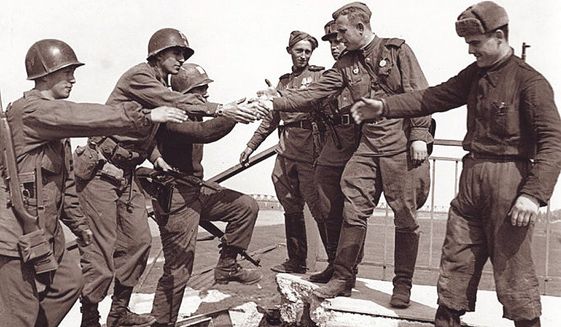
The American and Soviet forces linked up on the Elbe River on April 25, 1945. On April 30, 1945, the Reichstag was captured, which signaled the military defeat of the Third Reich. Many changes in leadership came about during this period. On April 12, 1945, President Franklin Delano Roosevelt passed away. Harry Truman is now the new President. Also, on April 12, 1945, Allied forces from America liberate the Buchenwald and Belsen concentration camps. What they see horrify them. They see massive stakes of human bodies being dead and human survivors starving for food. There were a truckload of bodies from the Buchenwald concentration camp. The Nazis were about to burn them, but the troops from the U.S. 3rd Army came to liberate the camp. One survivor is Elie Wiesel who would be a Nobel Peace Prize recipient in the future. He is a great author. In April, the Allies discover stolen Nazi art and wealth found in German salt mines. Supreme Allied Commander Eisenhower, along with Generals Bradley and Patton, inspected art treasures stolen by the Nazis and hidden in underground salt mines. The Reichsbank wealth, SS loot, and Berlin museum paintings that were removed from Berlin to a salt mine in Merkers, Germany. The Nazis also stole wealth including art from Jewish people too. The Nazis were evil criminals and thieves.
Benito Mussolini was killed by Italian partisans on April 28. 2 days later, Hitler committed suicide and was succeeded by Grand Admiral Karl Donitz. German forces surrendered in Italy on April 29. Total and unconditional surrender was signed on May 7, 1945, which was to be effective by the end of May 8th. The Germany Army Croup Centre resisted in Prague until May 11.
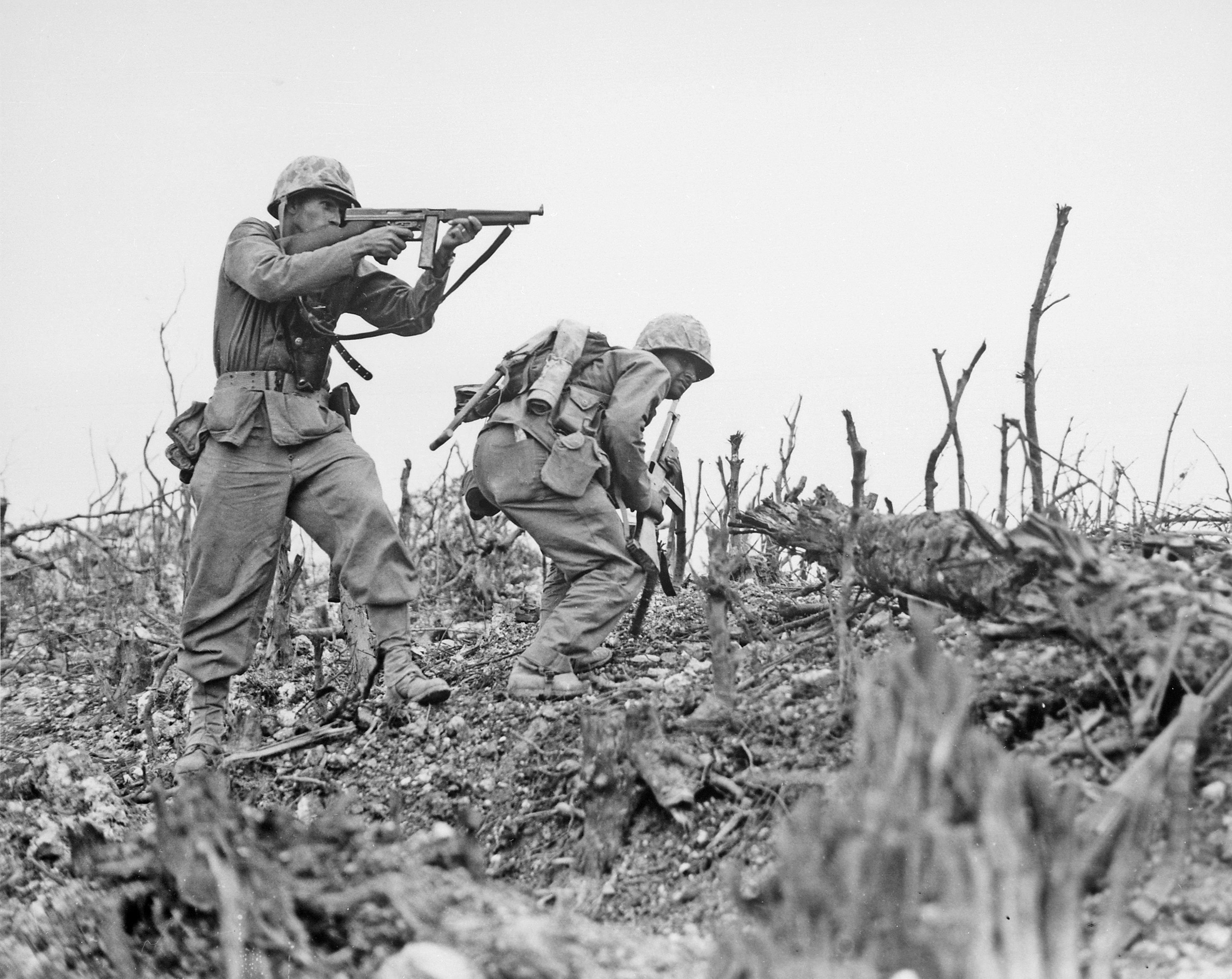
The end of the war in the Pacific was very brutal. In the Pacific theater, American forces worked with the Philippine Commonwealth forces to advance in the Philippines. They fought in Leyte by the end of April of 1945. They landed on Luzon in January of 1945 and captured Manila in March following a battle, which reduced the city to ruins. There was fighting in Luzon, Mindanao, and other islands of the Philippines until the end of the war. On the night of March 9-10, 1945, B-29 bombers of the US Army Air Forces struck Tokyo with incendiary bombs which killed 100,000 people in a few hours. That was an obscene war crime. Over the next few months, American bombers firebombed 66 other Japanese cities. This caused the destruction of untold numbers of buildings and the deaths of between 350,000 to 500,000 Japanese civilians. In May 1945, Australian troops have landed in Borneo, over running the oilfields there. By March, British, American, and Chinese forces defeated the Japanese in northern Burma. The British reached Rangoon by May 3. Chinese forces started to counterattack in the Battle of Hunan that happened between April 6th and June 7th, 1945. American forces moved towards Japan. U.S. troops take Iwo Jima by March and Okinawa by the end of June. At the same time American bombers were destroying Japanese cities, American submarines cut off Japanese imports. This reduced dramatically Japan’s ability to supply its overseas forces.
The Philippines were liberated by July 5, 1945. July 11, 1945 would be when Allied leaders would meet in Potsdam, Germany. They confirmed earlier agreements about Germany and wanted unconditionally sur render for all Japanese forces in Japan. The Japanese government was conflicted on whether to make peace now or later. In early August, the United States dropped atomic bombs on Hiroshima and Nagasaki. In the past two decades, we have more than enough research to document how military experts said that it was unnecessary to drop atomic weapons in Japan since the Japanese were nearly defeated and the changing of the unconditional surrender proposal would have ended the war sooner. Thousands of Japanese died as a product of the drops of two atomic bombs, which was totally evil. Between the two bombings, the Soviets fulfilled their promise in the Yalta agreement by invading Japanese held Manchuria and quickly defeated the Kwantung Army. That was the largest Japanese fighting force. The Red Army also captured the Sakhalin Island and the Kuril Islands. By August 14, 1945, Japan surrendered. The surrender documents finally were signed abroad the deck of the American battleship USS Missouri on September 2, 1945. This ended the war completely.

VE Day
This was the time when people celebrated the Nazis formally surrendering to the Allied Powers. The date is on May 8, 1945.


The Atomic Bomb
The dropping of the atomic bombs in Hiroshima and Nagasaki by the United States were one of the most controversial and devastating actions of World War II. The myth that Japan was not going to surrender has been exposed by documentaries, authors, military generals, and historical scholars especially in the past 20 years. Today, we know a greater amount of information about the atomic weapons program and the attacks in Japan. To start, we must begin with the origins of the atomic weapons program of America. America began the program first in fear of the Nazis having nuclear weapons technology, which could be used against Americans, etc. Yet, the Nazis abandoned atomic weapons research early on during WWII. In December 1938, German physicists split the uranium atom. Many feared that the Nazis would have this technology. Therefore, Albert Einstein, Szilard, and Eugene Wigner wrote letters to President Roosevelt to create a program to establish an atomic bomb. FDR agreed to start it. Later, Einstein said (to chemist Linus Pauling) that he regretted sending Roosevelt a letter in favor of establishing an atomic bomb, because of its savage nature. At first, the process of creating such a bomb in America was slow. Wartime science administrator James Conant put Nobel Prize winning physicist Arthur Holly Compton to work on the bomb design. First, scientists have to be called up like J. Robert Oppenheimer (who was a charismatic theoretical physicist. He admitted that he had ties to Communist organizations and he was a strong progressive person), Edward Teller, and Hans Bethe. In Met Lab in the city of Chicago, scientists were successful in creating the first nuclear chain reaction on December 2, 1942. They were lucky that they didn’t blow up the city of Chicago.
Next, we have the establishment of the Manhattan Project being created by Americans in Los Alamos, New Mexico. This project was headed by Brigadier General Leslie Groves. Groves and Oppenheimer worked together, but each man had different personalities. Groves was conservative and Oppenheimer was more progressive. Groves had a more angry personality. Groves’ assistant was Lieutenant Colonel Kenneth Nichols. When Roosevelt passed away, Truman was President. Truman was heavily influenced by Stimson and others who never trusted the Soviet Union. Truman was notified about the atomic bomb development program. Scientists exploded the atomic bomb for the first time on July 16, 1945. It happened in the desert outside of Alamogordo, New Mexico. The Trinity test exceeded expectation. It was an 18.6 kiloton blast. Oppenheimer said the following when he thought about the test: “…I am become death, destroyer of worlds.” Groves gloated over the test as being great. Truman soon heard word of it. Truman never really trusted the Soviet Union. Truman wanted to use the bomb as leverage against the Soviet Union, so the Soviets would be subordinate to U.S. interests involving WWII and beyond. The Soviets planned to invade Japan, but the Soviets didn’t trust Churchill who was bellicose against the Soviets for years. Roosevelt was more conciliatory and moderate when dealing with the Soviet Union, which is why FDR called Stalin “Uncle Joe.” Japanese leadership desired to surrender only if the unconditional surrender proposal from the U.S. was eliminated including the elimination of the imprisonment of the Emperor of Japan. The U.S. would not budge and refused any concessions on the unconditional surrender language. Politicians and scientists from America tried to inspire Truman to not drop the bomb. Truman refused and he decided to drop it. Truman was influenced by Byrnes and Stimson, who were reactionaries on foreign policy matters. Byrnes was an outright racist and segregationist.



Even Dwight D. Eisenhower and General Douglas MacArthur opposed the decision to drop atomic weapons in Japan. In 1989, historian Gar Alperovitz reported, “American leaders knew well in advance that the bombing of Hiroshima and Nagasaki was not required to bring about Japan’s surrender;” and later, in his 847-page The Decision to Use the Atomic Bomb (Random House, 1995), “I think it can be proven that the bomb was not only unnecessary but known in advance not to be necessary.” The popular myth “didn’t just happen,” Alperovitz says, “it was created.” Adm. William Leahy, the wartime Chairman of the Joint Chiefs of Staff, wrote in 1950, “It is my opinion that the use of this barbarous weapon at Hiroshima and Nagasaki was of no material success in our war against Japan. The Japanese were already defeated and ready to surrender.” Japan by 1945 was on the verge of defeat with their cities and towns being massively bombed. A simple change in the surrender terms could have caused Japan to surrender much earlier than September of 1945. On July 25, 1945, U.S. General Carl Spaatz, Commander of the Strategic Air Force in the Pacific received directive to drop the atomic bomb in Japan. Enola Gay was the plane that housed the “Little Boy” A-bomb. It was dropped in Japan from 1,900 feet above Hiroshima with a force equivalent to 12,500 tons of TNT. This act was a crime against humanity and a crime against God. It was totally evil. Both basts were outright war crimes without question. Even I can’t detail the destruction in full detail. Children died instantly. Grown human beings died with the organs dissolved. Many parts of Hiroshima were burned to the ground. The skins of men, women, and children were burned off their flesh. Human death was everywhere. About 140,000 people died in Hiroshima by the end of the year. The second bomb was dropped in Nagasaki on August 9, 1945. It had about 22,000 of TNT in equivalent. 70,000 died in Nagasaki by the end of 1945 from the effects of the atomic bomb. Even to this day, the victims of those atomic blasts suffer illness. The atomic bomb didn’t end world conflict at all. It started the Cold War and the Soviets had atomic bomb technology from a spy working inside of Los Alamos. On August 16, 1945, Gen. Wainwright, a POW since May 6, 1942, was released from a POW camp in Manchuria. The Soviets dropped their first atomic bomb in August 29, 1949. The evil atomic bomb drops in Japan reminds us about how valuable the dignity of human life is and it shows us the destructive nature of war is.

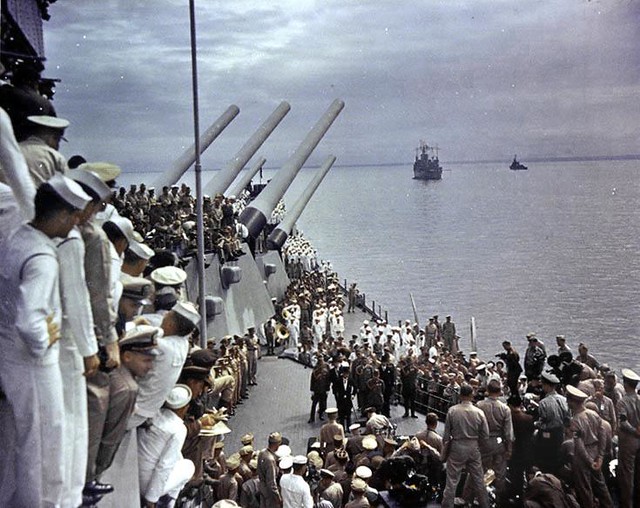
VJ Day (The Axis Powers are totally Defeated)
On September 2, 1945 was the time when Japan officially surrendered.

Nuremberg
The Nuremberg Trials were some of the most important parts of World War II history. On September 15, 1944, Colonel Murray Bernays of the War Department’s Special Project Branch proposed part of the framework that will be used in Nuremberg. Bernays proposed treating the Nazi regime as a criminal plot. William Chanler (or a friend of the Secretary of War Stinson) suggested another part of the framework, which is about waging of a war of aggression a crime. By February 1945 at Yalta, FDR, Churchill, and Stalin all agree that a prosecution of Axis leaders should follow the expected conclusion of World War II. On April 1945, President Truman asked Samuel Rosenman to approach the Supreme Court Justice Robert Jackson and inquire about his willingness to serve as chief U.S. prosecutor in a war crimes trial. Robert Jackson was appointed as chief U.S. counsel for the prosecution of Nazi war criminals by President Harry Truman on May 2, 1945. Hermann Goering surrenderd to the Allies on May 6, 1945. He was transferred to Bad Mondorf in Luxembourg. In Flensburg, Germany, the British took many of the Nazis to be tried in the Major War Figures Trials (like Donitz, Jodl, Keitel, Rosenberg, and Speer. Himmler committed suicide) in May 23, 1945. By June 26th of the same year, Robert Jackson departed from Washington, D.C. to meet with his Allied counterparts in London to discuss the legal proceedings against Nazi officials. There are disagreements on what to do. The Americans and the British wanted the adversarial system while the French and the Soviets desired the inquisitive system. The Allies agreed to prohibit the use of the defense of superior orders, although they agree to allow its consideration in the mitigation of sentence. When Robert Jackson visited Nuremberg, it’s a city that has been 91% destroyed by Allied bombs. In July of 1945, he goes into the Palace of Justice and recommended it as a site for the upcoming trials. The Soviets wanted the trial to take place in Berlin within their zone of occupation. The London Agreement was signed in August of 1945 that enabled the prosecution of war criminals.
Major War criminals then are housed in Luxembourg and then are flown to Nuremberg where they are incarcerated in prison adjacent to the Palace of Justice by August 12, 1945. Robert Jackson meet with President Truman in September. Truman proposed to name former Attorney General Francis Biddle as the American judge at Nuremberg, but Jackson didn't think highly of Biddle and suggests other people. Yet, Biddle got the appointment. By October, Sir Geoffrey Lawrence (or the British representative) was elected President of the International Military Tribunal or the IMT. Major war criminals are indicted in the same month too. Robert Ley committed suicide before his trial. Ley was the former chief of the German Labor Front. The trial of the major war criminals by the International Military Tribunal started on 10 a.m. in Nuremberg, Germany on November 20, 1945. During the next day, all of the defendant plead “Not Guilty.” Goering wanted to make a statement, but he was prevented from doing so. Justice Robert Jackson delivered his opening statement for the prosecution.
On November 29, 1945, the prosecution introduced a film shot by Allied photographers in the liberated areas. The footage is graphic and it describes the Nazi horrors. It caused weeping in the courtroom. Some defendants appeared shocked by what they see and some seem bored. On December 13, 1945, the prosecution introduces the grisly evidence from Buchenwald concentration camp that shown tattooed human skin and the bodies of the victims of the Holocaust. By 1946, people testify including Nazis. In October 1, 1946, the verdict comes out against the major war criminals are handed down by the International Military Tribunal. 11 of the 21 defendants are sentenced to death. All appeals are rejected. Goering committed suicide by swallowing a smuggled cyanide pill. 10 of the war criminals are hanged in Nuremberg on October 16, 1946. More trials will come up too which will sentence Nazi war criminals for their evil crimes in the years to come as well.

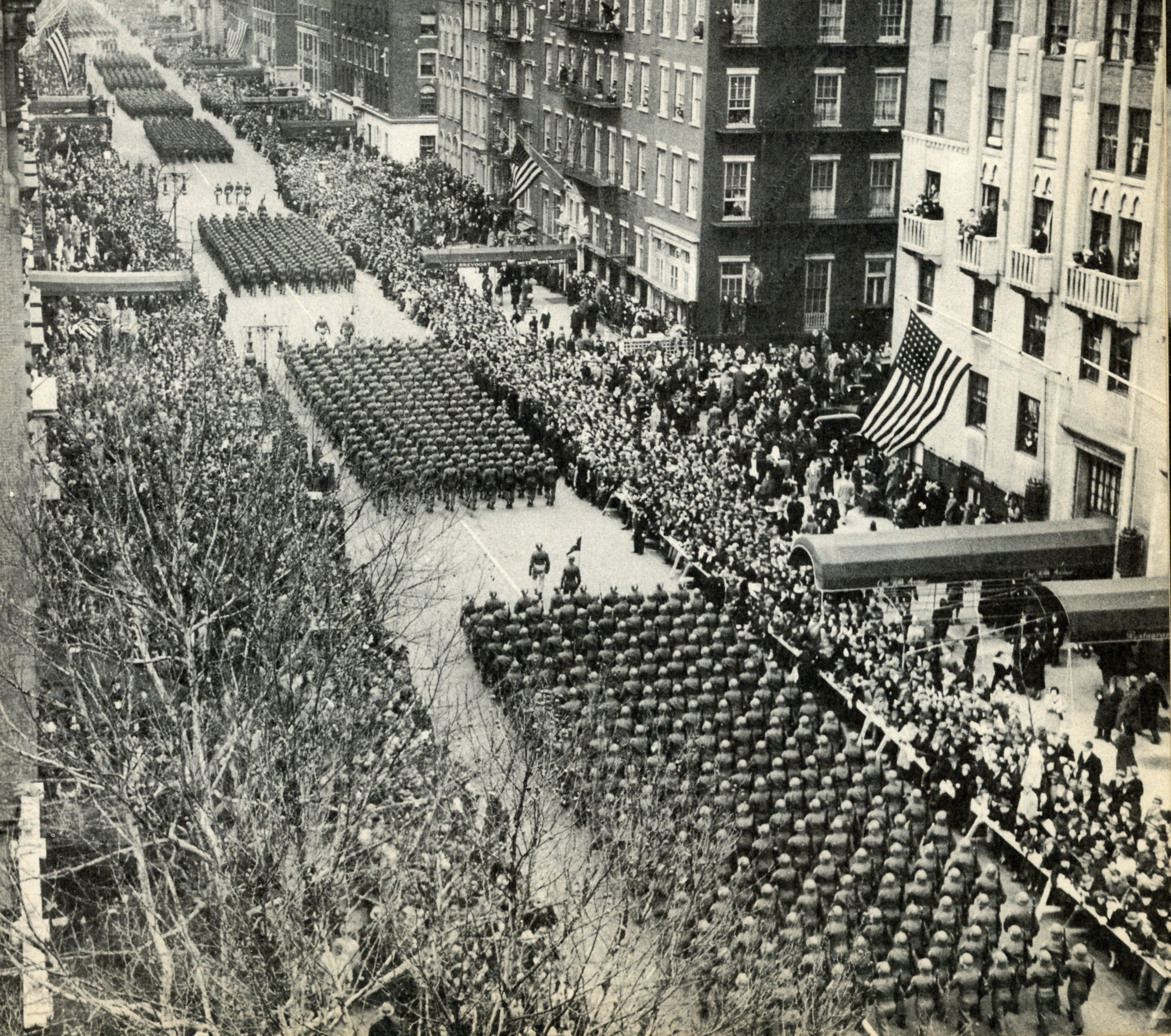
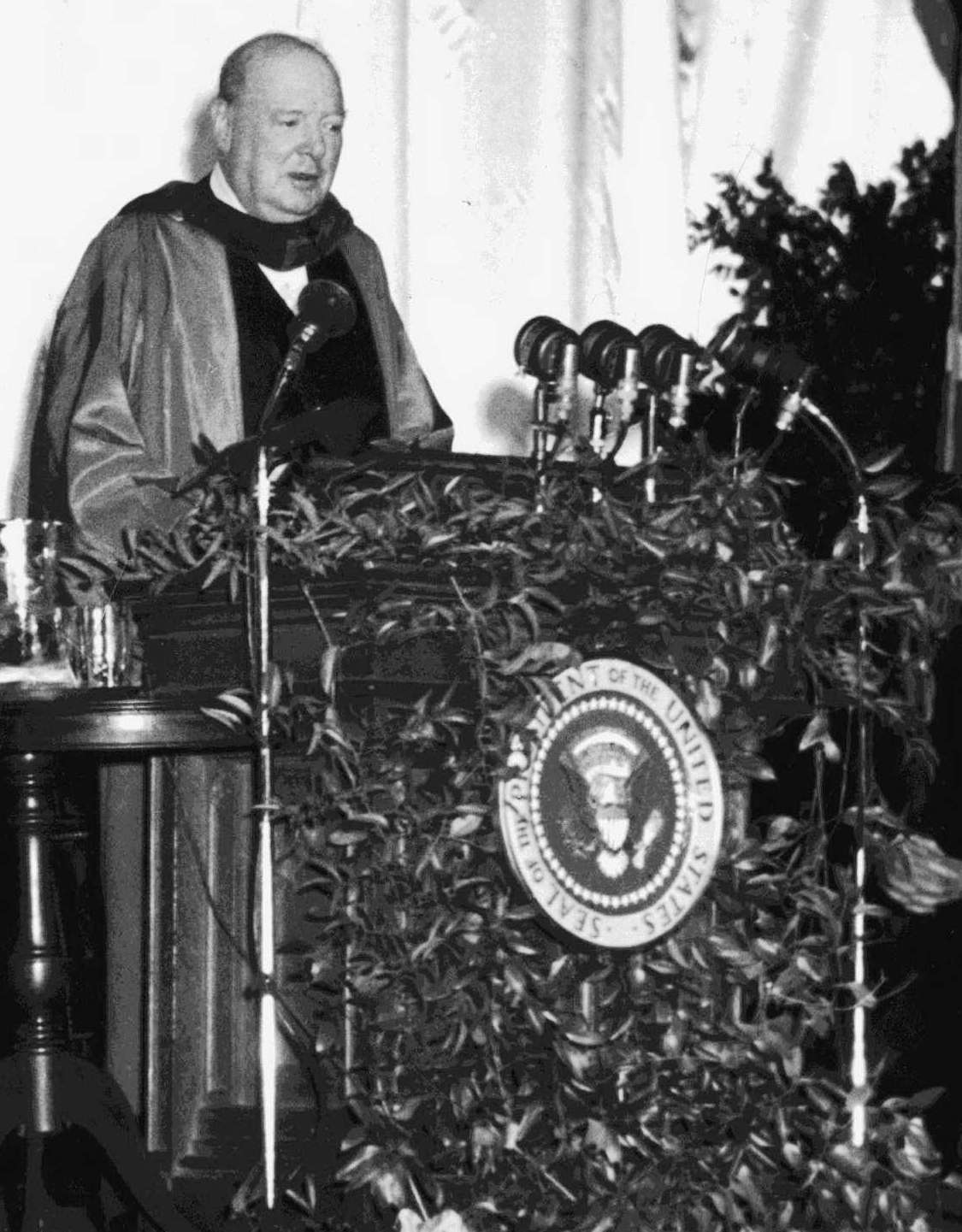
Conclusion
The Second World War caused massive consequences for the world that affect us to this very day. World War 2 was an inter-imperialist war between capitalist & fascist powers who wanted the mass resources of the world. They competed for not only markets, but for the mineral wealth of the Earth too. After the war, the Axis Powers were defeated convincingly. Not to mention that the Soviet Union grew in power and influence after the war as they contributed mostly to the defeat of the Nazis in Europe. America was a strong victor too. After World War 2, the Cold War existed (between America and the Soviet Union. After the Cold War, the Soviet Union would end and be replaced with multiple nations including Russia). The USA went from having a small Empire before 1941 to being the largest empire in the world by 1945. Today, after seventy years of war, America has hundreds of military bases worldwide, massive telecommunications services, massive satellites in space, multiple nuclear weapons, and huge capitalist markets. America rebuilt European capitalism via the Marshall Plan. After WWII, some of the Allies formed NATO as a way for them to enforce Western policies globally. The American empire grew into unprecedentedly levels after European colonial empires declined in power. The American Empire readily supported dictators after WWII instead of the interests of the masses of the people. For example, the U.S. aided Suharto in Indonesia, the Shah in Iran, Mobutu in Zaire, Georgios Papadopoulos of Greece, Pinochet in Chile, and other authoritarian dictators globally. The West's CIA not only committed fraud, but terrorism internationally. The CIA evolved from the WWII’s OSS. The United Nations would be born in October 24, 1945. The original vision of the United Nations (as eloquently outlined by the late President Franklin Delano Roosevelt) has been shattered, because the UN is dominated by imperial countries and capitalist interests. We witness the massive growth of nuclear weapons since 1945. The G8 run most of the policies of the United Nations (despite how many sincere people are in the U.N).
The IMF, the World Bank, GATT, and other institutions which were created after World War II execute free-market economic policies. The American Empire now is involved in executing the policies of the so-called “war on terror,” which has caused many deaths too. We witnessed he global recession of 2007-8 (caused by massive Wall Street speculation and other actions), which has further expanded economic inequality, poverty, and other economic problems globally. There is the rise of China in the 21st century and the strength of Russia is not gone either. Also, WWII has inspired many good people who fought for social justice and human dignity. The Axis Powers being gone from the Earth is a good thing. German and Japanese imperialism was defeated in 1945. Now, we still face Western imperialism in our generation. When ISIS and Al-Qaeda kill innocent human beings, then that is wrong. When Western drone strikes kill innocent civilians, then that's wrong too. The expansion of the human rights of people of color, of women, and of other human beings is a good thing. The ending of overt European colonialism in many parts of the world is also a great thing. We have a long way to go. We learn lessons about World War II, so we can never repeat such a destructive war ever again. To this very day, Nazi war criminals have been caught and brought to justice. We ought to never lose hope. There is a remnant in our generation who desire peace and tranquility. There is a remnant in our time who loves the truth and wants an end to oppression in the world. Also, we have to continue in the fight against fascism. Fascism didn’t die in 1945. It continues today. We will never support or endorse racism, xenophobia, anti-Semitism, Islamophobia, classism, misogyny, and any other injustice. We want freedom and justice for all in the human race.
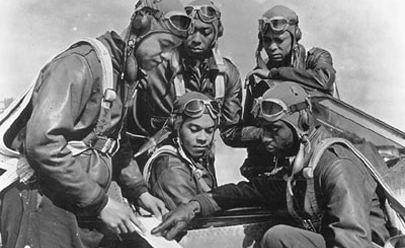
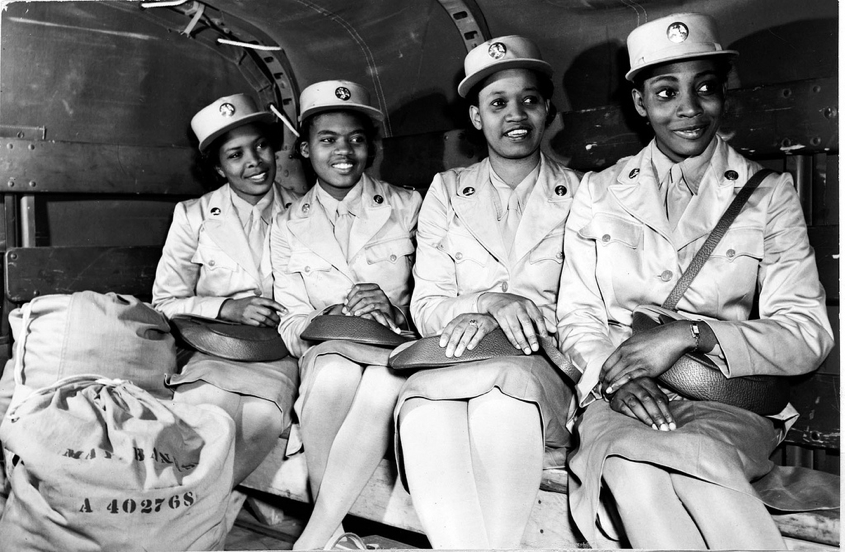

Appendix A: African Americans and World War II
African Americans had a huge role in the events of World War II. To get a great picture of what this time was, we have to explain what was happening. America during WWII was filled with lynchings, racial discrimination, riots, labor strikes, and other serious events. Many black Americans joined WWII for many reasons. Black people were drafted to go into war. Many African Americans felt that if they fight fascism overseas then they would experience racial justice after the war was over. There were many who opposed the war since they viewed the war as representative of hypocrisy (since the West was fighting bigotry overseas while black people suffered racism at home). Yet, I’m glad that the Axis Powers were defeated by the Allied Powers. I don’t agree with the droppings of atomic bombs in Japan though. Back then, the Armed Forces were segregated by race. So, there were separate black units fighting in Europe and Asia. Black people were forced to have menial jobs mostly in the Navy. During that time, the Marines had separate units based on race. In 1776 and 1777, a dozen Black American Marines served in the American Revolutionary War. From 1798 to 1942, no black person served in the Marines.
There were many rebellions on U.S. bases worldwide by black people from 1942 to 1945. The reasons are that black people suffered discrimination, racism, assaults, and murder by racists. Therefore, these rebellions existed along with protests made by Brothers and Sisters against racial oppression. There were racial riots in Mobile, Los Angeles, Beaumont, Tex, Harlem, and Detroit in 1943 alone.
In October 1940, Benjamin Oliver Davis, Sr. was named the first African American general in regular army. On January 13, 1941, the U.S. Army formed the 78th Tank Battalion. This was the first black armor unit. The tankers reporters to Fort Knox, Kentucky as a means for them to prepare for armored warfare training in March of 1941. The 78th was redesigned on May 8, 1941 as the 758th Tank Battalion (Light). This was the first of the three tank battalions compromising the 5th Tank Group, which was made up of black enlisted men and white officers. The other two tank battalions were the 761st and 784th Initially inactivated on September 22, 1945 at Viareggio, Italy, the 758th was reactivated in 1946 and later fought in the Korean War as the 64th Tank Battalion. In 1941, the U.S. Army created the Tuskegee Air Squadron who will soon be known as the Tuskegee Airmen (they were comprised at first of the 99th Pursuit Squadron and later the 332nd Fighter Group). The U.S. Army Air Corps trained black pilots in July 19, 1941. They were known for flying P-51 Mustang fighters. The Tuskgee Airmen never lost an escorted plane to the enemy during the course of World War II. They were 926 members of the heroic Tuskegee Airmen. They carried out hundreds of escort missions. A. Philip Randolph was supportive of WWII and he wanted civil rights for African Americans.
A. Philip Randolph, Bayard Rustin, and A. J. Muste proposed a march on Washington back during the 1940’s to protest racial discrimination in war industries and propose the desegregation of the American Armed forces. Franklin Delano Roosevelt feared this march and wanted to prevent it. So, he issued the Executive Order 8802 or the Fair Employment Act (on June 25, 1941), which ending discriminating in the war industries. This caused A. Philip Randolph to end his plans for a March on Washington. Another march will come later by 1963. Some people felt betrayed because Roosevelt’s order applied only to banning discrimination in the war industries and not the armed forces. Howard P. Perry was the first African-American US Marine Corps recruit following Executive Order 8802. The Fair Employment Act was historic in the fight for African American labor rights. In 1942, there are about 18,000 black people gathered in Madison Square Garden where A. Philip Randolph starts his campaign to fight discrimination in the military, in war industries, in government agencies, and in labor unions. In December 8, 1941, the United States enters World War II following the attack on Pearl Harbor. Dorris “Dorrie” Miller is later awarded the Navy Cross for his heroism during that battle.
During World War II, a massive migration of African American travel from the South to the North, the Midwest, and the West. Some work in factories and some work in other jobs. This migration influenced the development of the modern Civil Rights Movement in about a decade later.
In 1942, Charity Adams Earley became the first black woman commissioned officer in the Womens Army Auxiliary Corps (WAACs) while serving at Fort Des Moines. In 1943, the Naval Academy at Annapolis and other naval officer schools accept African American men for the first time. Also, in 1943, the Detroit Race riots happened in June 20-21, which killed 34 people (including 25 black Americans). Other riots would happen in Harlem, Mobile, Alabama, and Beaumont, Texas. The first black cadets graduate from the Army light School at Tuskegee Institute, Alabama. In the summer of 1943, there were 1400 African American soldiers of the 93rd Infantry Division and the 32nd and 33rd companies of the Womens Army Auxiliary Corps (with approximately 300 women) being stationed in the Arizona desert at Fort Huachuca for training. They are the largest concentration of black military personnel in the history of America during that time. Entire African American crew in 1943 staffed the two American Navy Destroyer ships, the USS Mason and the submarine chaser PC1264.
In 1943, the black 99th Pursuit Squadron or the Tuskegee Airmen fly its first combat mission in Italy. In 1944, there was the Port Chicago Munity. It first happened after a horrendous explosion on an ammunition ship docked at the Port Chicago Naval Base on San Francisco Bay. The explosion on July 17 killed 320 men including 202 African American sailors, who comprise half of the black personnel at the naval facility. When 50 black sailors refuse to return to the ships until their safety concerns are addressed, the Navy court-martials them for mutiny. All are convicted and sentenced to prison. It was only after World War II ended when most the convicted people were quietly released. In April of 1945, 2 U.S. Black soldiers were killed by military police at a French army camp for allegedly talking to French women employed there. There are tons of stories of African American soldiers who executed heroism during WWII.
The 6th Armored Division and the 80th Infantry Division liberated the concentration camp of Buchenwald. African-American soldiers from Headquarters and Services Co. of 183rd Engineers Combat Battalion, 8th Corps, Third Army arrived at Buchenwald on April 17, 1945. Among these soldiers was Leon Bass. The 183rd Engineer Combat Battalion was attached to the 1126th Engineer Combat Group in April 1945. On April 12, 1945, the 1126th Engineer Combat Group was sent to the town of Eisenach. This town was 100 kilometers from the Buchenwald concentration camp. Five days later, on April 17, 1945, several black soldiers were sent to Buchenwald to deliver some supplies. For most of the liberated prisoners, this was the first time they had ever seen a black man, and many of them would recall it later in their survivor accounts. Dr. Leon Bass and William A. Scott, III both saw Holocaust victims and both said that they liberated Buchenwald. Gunther Jacobs was a survivor of Buchenwald who had spent three and a half years in Nazi concentration camps. In an interview with Jeff Bradley of the Denver Post in 1989, Jacobs said: “The first Black people I ever saw in my life were the Black soldiers who liberated us on April 11, 1945.” Jacobs told Bradley that he had never been able to speak out about what happened at Buchenwald, but he wanted to speak now “on behalf of his Black liberators” whom he had never thanked. The Black GIs starred at the Holocaust victims and many of them cried. So, the prisoners in the Buchenwald concentration camp liberated themselves at 3:15 p.m. on April 11, 1945 when they took over the camp, killing some of the guards. The rest of the guards fled into the nearby woods. When American soldiers in the 6th Armored Division saw the prisoners chasing down the guards and shooting them, they followed the action to the camp. The next day, soldiers from the 80th Infantry Division arrived in Weimar, five miles from the camp, and saw prisoners roaming around the town. The soldiers followed the prisoners to the camp where they joined in as the prisoners beat to death the SS guards who had been captured. According to one account, 76 SS soldiers were killed by the Americans.


In 1945, Colonel Benjamin O. Davis, Jr. is named Commander Field, Kentucky. He is the first African American to command a military base. Della H. Rainey was born in Suffolk, VA. in January 10, 1912. She graduated from Lincoln Hospital School of Nursing in Durham, N.C. She was the first black nurse commissioned as a lieutenant in the U.S Army Nurse Corps or ANC during World War II. She served in Fort Bragg, N.C. She served in Alabama and was Chief Nurse at Fort Huachuca. She was promoted to captain in 1945. There were about 500 black nurses in the Army Nurse Corps during World War II. Recently, President Brack Obama met with the oldest living WWII veteran. She is an African American named Emma Didlake of Detroit. Emma joined the Women’s Army Auxillary Corps in 1943. She is 110 years old.

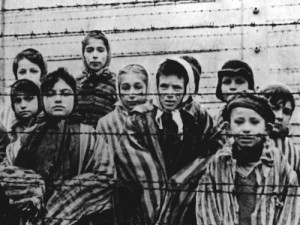
Appendix B: The evil Holocaust
There can be no discussion about World War II without discussion about the evil Holocaust or the Shoah (which means destruction in the Hebrew language). The Holocaust was systemic genocide against human beings by the Nazi regime. The Holocaust murdered six million Jewish human beings and millions of other human beings. The word Holocaust has Greek origins meaning “sacrifice by fire.” The Nazis believed in the racist lie that Jewish people and people of color (including others) were genetically inferior and they must be exterminated. Racism is always linked to genocide. The myth of the superior race was promoted by the Nazis from Hitler, Himmler, etc. Not only were the Jewish people murdered. The Holocaust killed Jewish people, Roma (who live in Hungary, Romania, and other places of Eastern Europe), the disabled, those with mental illness, Slavic human beings (like the Poles, Russians, the Serbs, etc.), black people, socialists, Communists, Jehovah Witnesses, homosexuals, Freemasons, etc. The Jewish population of Germany was about 566,000 when Hitler was Chancellor of Germany in 1933. Hitler used the SA and the SS to oppress people as an auxiliary police. On March of 1933, the Nazis opened Dachau concentration camp near Munich. Then, came Buchenwald near Weimar in Germany. There was also Sachsenhausen near Berlin in northern Germany and Ravensbruck for women. These camps were opened in March 22, 1933. The Nazis boycotted Jewish shops and businesses in April 1, 1933. The Nazis would strip Jewish immigrants of German citizenship. In July, the Nazis forced sterilized people who were found to have a certain illness or condition by July 1933. The rights of Jewish people were stripped. The Nazis passed a law in November to allow beggars, the homeless, and the unemployed to be sent into concentration camps. Jewish people in Germany were banned to join unions, banned to join the military, and banned to join Jewish cultural Unions in 1935. Jewish people are registered by the Nazis. The Nazis destroyed the synagogue in Nuremberg too on August 11, 1938. The Holocaust has been promoted in Mein Kampf and it has been called the “Final Solution.” The racist Nazis scapegoated the Jewish people for economic problems and racist caricatures existed in German newspapers and evil posters.


During the war, Jewish people and others were forced by the Nazis and their collaborators into ghettos, transit camps, and forced labor camps. Kristallnacht or the Night of the Broken Glass came about in November 9-10, 1938 as ordered by Nazi propagandist Joseph Goebbels. This event was a coordinated, massive attack by the Nazis against Jewish people all over Germany. It came after Herschel Grynszpan (or a 17 year old Jewish person living in Paris) shot and killed a member of the German embassy staff (named Ernst vom Rath). Herschel was against the poor treatment that his father and family suffered at the hands of the Nazis. On November 9, the regular German police stood by as Nazi storm troopers along with the SS including the Hitler Youth members beat and murdered Jewish people. The Nazis broke into Jewish homes and brutalized Jewish women and children. Jewish businesses and more than 1600 synagogues were burned and destroyed in Germany, Austria, and other Nazi controlled areas. Some Germans found the violence offensive and helped their Jewish friends and neighbors. About 25,000 Jewish men were rounded up and later sent to concentration camps where they were often brutalized by SS guards and in some cases randomly chosen to be beaten to death. Worldwide, people condemned Kristallnacht as a racist terrorist campaign. 91 Jewish people were killed. Goring fined the Jewish people one billion marks when it was the Nazis who burned buildings, killed innocent Jewish people, and caused the discretion of scrolls. The fire department didn’t come to put out the fires. Shortly after Kristallnacht, the United States recalled its ambassador permanently. One quote from Nazi newspaper on January of 1941, Der Stürmer, published by Julius Streicher when he said: "Now judgment has begun and it will reach its conclusion only when knowledge of the Jews has been erased from the earth."
"IBM and the Holocaust: The Strategic Alliance between Nazi Germany and America's Most Powerful Corporation" is a book by investigative journalist Edwin Black which details the business dealings of the American-based multinational corporation International Business Machines (IBM) and its German and other European subsidiaries with the government of Adolf Hitler during the 1930s and the years of World War II. In the book, Black outlines the way in which IBM's technology helped facilitate Nazi genocide through generation and tabulation of punch cards based upon national census data. The head of IBM back then was Thomas Watson (who met with Hitler in June of 1937 in Berlin. Thomas Watson was a member of the Bohemian Grove).
On March 1, 1943, American Jewish people in New York City hold a massive rally at Madison Square Garden to pressure the U.S. government to help the Jewish people of Europe. There were many great Jewish resistance leaders who opposed the Holocaust and Nazi tyranny. There was Mordechaj Anielewicz who was the leader of the Jewish Combat Organization during the Warsaw Ghetto Uprising. He was killed in action in 1943. Pawel Frenkiel was a Polish Jewish youth leader in Warsaw and a senior commander of the Jewish Military Union killed in action defending the JMU headquarters. Abba Kovner, was a founder of the United Partisan Organization in Vilna, who coined the phrase: "Let us not go like lambs to the slaughter!" The FPO was one of the first armed underground organizations in the Jewish ghettos under Nazi occupation.
When the Nazi spread across Europe, the Nazis and their collaborators persecuted Jewish people and non-Jewish people living in other places other than Germany too. Millions of Soviet prisoners of war were murdered or died of starvation, disease, neglect, or maltreatment. Many Polish and Soviet civilians were kidnapped and forced to be involved in forced labor in Germany and in Poland (when it was occupied by the Nazis). The Nazis used the Einsatzgruppen or mobile killing units to kill Jewish people, Roma, and Soviet state and Communist Party officials. The Wehrmacht and the Waffen SS killed more than one million Jewish men, women, and children. Many Jewish people were kidnapped and shipped to extermination camps all across Europe. People were gassed, shot, experimented on, and the whole nine yards.
Auschwitz was liberated by the Soviet Union’s Red Army on January 27, 1945. The death camp was located in southern Poland. Auschwitz was a place of some of the greatest crimes and horrors of the 20th century. From early 1942 to late 1944, transport trained sent Jewish people from throughout Nazi-occupied Europe to the gates of Auschwitz. The camp had the infamous slogan of “Arbeit macht frei” or Work makes you free. Over 1.1 million people were killed at Auschwitz. Hundreds of thousands of them were sent to gas chambers. Others were exterminated via starvation, overwork, disease, and hideous medical experiments carried out by people like Josef Mengele (who was called the “Angel of Death”). “People forget what Auschwitz was, and it terrifies me, because I know to what kind of hell it leads,” said Roman Kent, 85. He concluded his remarks at the 70th anniversary remembrance ceremony by stating, “We do not want our past to be our children's future.”
During the end of the war, SS guards moved camp inmates by trained or forced marches to try to prevent the Allied liberation of a large number of prisoners. Yet, the Allied forces heroically liberated concentration camp prisoners. The victims and survivors of the Holocaust would travel worldwide. Between 1948 and 1951, almost 700,000 Jewish people emigrated into Israel. Including 136,000 Jewish displaced persons from Europe. The last displacement camp (which was used by the Allies to help Holocaust survivors) ended by 1957. To this day, people are fighting to find, try, and convict Nazi war criminals.
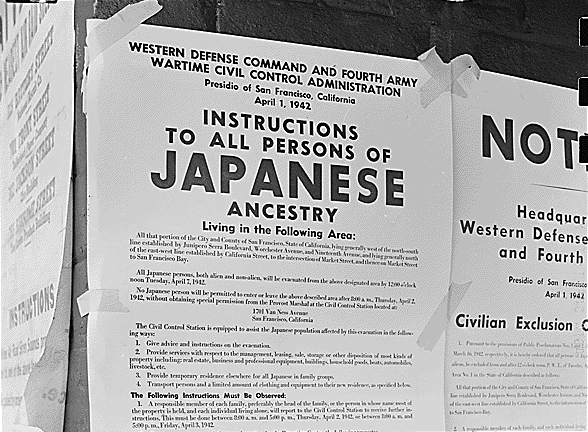

Appendix C: American Interment Camps
The internment of Japanese Americans during World War II was one of the greatest injustices of American history. A climate of xenophobia, racism, and bigotry has inspired the interment to take place. The Immigration Act of 1924 denied Japanese people (who even lived in America after 1907) the right to become naturalized U.S. citizens. The law also restricted further immigration from Japan. Some racist people expressed paranoid lies about tons of Japanese people wanting to have sabotage during the war, which wasn’t the case at all. These fears existed even before Pearl Harbor. Then, California Attorney General Earl Warren called for the internment of Japanese Americans. Lieutenant Colonel John L. DeWitt had massive anti-Japanese racism too. Even the racist FBI Director J. Edgar Hoover said to Attorney General Francis Biddle that mass evacuations aren’t necessary at first. Biddle informed Roosevelt that internment of Japanese people wasn’t necessary. There were still racists who questioned the loyalty of Japanese people in America. Later, President Franklin Delano Roosevelt (who was right on many issues) made one of his greatest mistakes during his Presidency when he signed Executive Order 9066. This executive order laid the groundwork for the evacuation and incarceration of Japanese people and Japanese Americans, from California, Washington, and Oregon. Two thirds of Japanese people in America were U.S. citizens by birth.
Between 110,000 and 120,000 Japanese human beings were interned. The internment camps were mostly in the West Coast, including Texas, Kansas, Louisiana, New Mexico, etc. Most of the camps were in California. Japanese people were told to carry items and leave. Many people stole the resources of the homes and farms of the Japanese when they went into the internment camps. The conditions of the internment camps were horrible. People worked in the harsh elements. The camps were surrounded by barbed wire. Workers were paid very less in money .Many Japanese doctors received $228 per year and a whites senior medical officer earned $46,000 per year. By February 1943, the United States government allowed some Japanese Americans to fight in WWII via segregated units. Those who fought were Nisei or second generation Japanese American people. The Issei were first generation Japanese Americans. In June 1943, the Supreme Court in the Gordon Kiyoshi Hirabayashi v. United States, decision ruled to maintain the application of curfews against members of a minority group when the nation was at war. The defendant, Gordon Kiyoshi Hirabayashi, was a University of Washington student who was accused of violating the curfew and exclusion order, designated a misdemeanor by Public Law 503, a Congressional statue introduced to enforce Executive Order 9066 and any subsequent military order. The Supreme Court was wrong on that issue. It would take decades after WWII for a national apology for the Japanese victims of interment would occur and the $1.5 billion for survivors of the internment camps. Many German Americans (in the number of a total of 11,507 human beings) and Italian Americans (which lasted from 1941 to 1945) were interned in bases and locations nationwide. In 2001 the US Attorney General reported to Congress on a review of treatment by the Department of Justice of Italian Americans during World War II. In 2010, the California Legislature passed a resolution apologizing for US mistreatment of Italian residents during the war.
By Timothy
This work is dedicated to the victims of the Holocaust, to the resistance movements against the Nazis and against other Axis fascists, to the Allies soldiers who fought tyranny, to the innocent victims of the internment camps of America, to other heroes of WWII, and to the civilians who died during WWII.
No comments:
Post a Comment